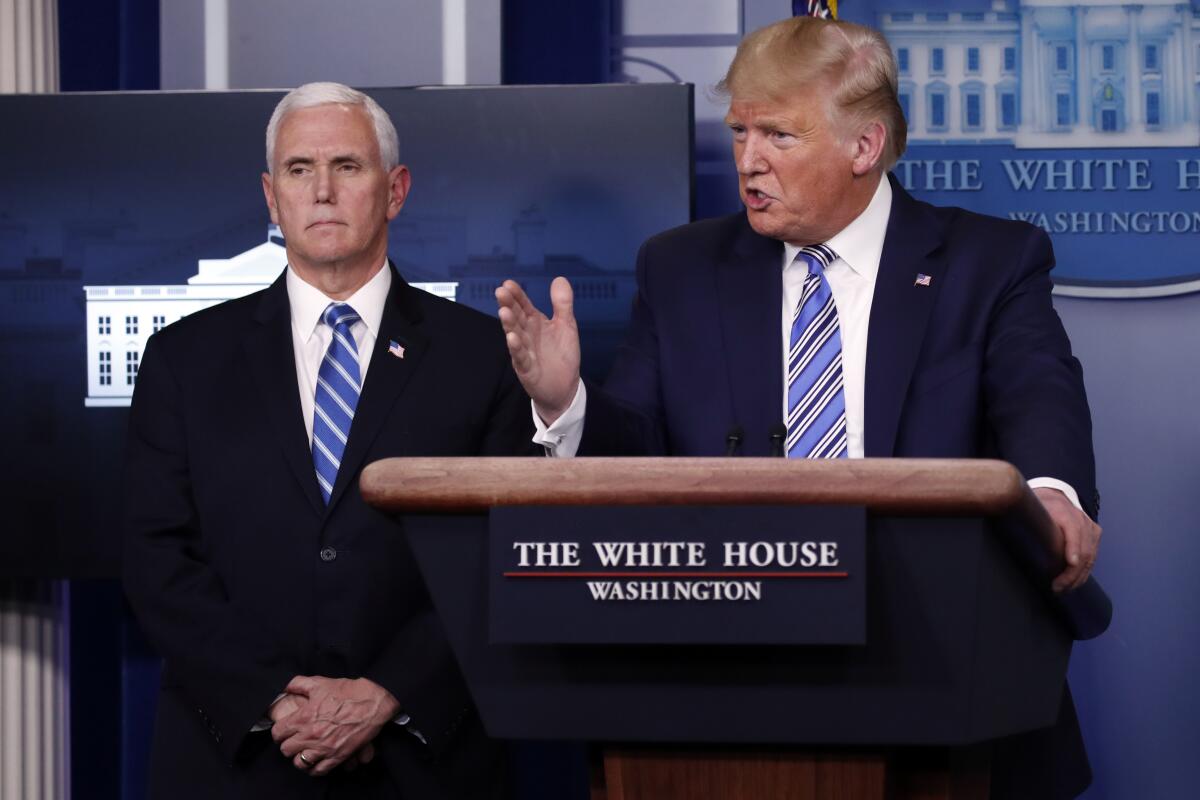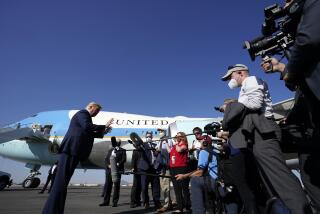Frustrated by economic damage, Trump says he may ease restrictions

WASHINGTON — President Trump, desperate to turn around the cratering economy, indicated Monday that he is likely to ease within weeks extreme restrictions on commerce that were intended to stem the deadly COVID-19 pandemic, resisting advice from public health advisors who have urged a longer shutdown.
Trump did not offer specifics but suggested he would modify the administration’s call to close schools and businesses, encourage people to work from home and avoid gatherings following a 15-day period that ends March 30.
“At some point, we’re going to open up our country, and it’s going to be fairly soon,” Trump told a White House news conference. “I’m not looking at months, I can tell you right now.”
Any easing of federal public health guidelines may have little immediate impact on millions of Americans, including those working or sheltering from home in California and New York, two of the worst-hit states, given the restrictions that numerous governors and mayors have imposed and the decision by many businesses to suspend operations.
But a change in federal policy could weaken public resolve and lead to uneven practices, with Americans in some areas returning to work or school while others stay home. Public health experts warn that a patchwork response could spur dangerous new outbreaks of the coronavirus, especially if the lag in testing and tracking continues.
Even as confirmed U.S. infections rose to nearly 44,000 and the death toll topped 500 Monday, Trump expressed frustration with the fast-mounting economic carnage, including soaring unemployment and a plummeting stock market.
“If it were up to the doctors, they may say, ‘Let’s keep it shut down for a couple of years. Let’s shut down the entire world,’” Trump said. “And you can’t do that with a country, especially with the number one economy anywhere in the world, by far.”
Some restrictions could be lifted sooner than next week. Speaking at the same news conference, Vice President Mike Pence indicated that the Centers for Disease Control and Prevention would issue new guidelines on Tuesday to allow more people to resume work outside their homes if they wear masks.
Eerie photos and stunning aerial shots show what California looks like under Gov. Newsom’s “stay at home” order.
Trump’s surgeon general, Dr. Jerome Adams, warned earlier Monday that the outbreak will worsen this week because “not enough people ... are taking this seriously,” citing those flocking to beaches in California or looking at cherry blossoms on the National Mall in Washington.
“We really, really need everyone to stay at home,” he said on NBC.
Allowing normal life to resume too soon could backfire in the form of lost lives and economic devastation, some experts warned. They said it could be weeks before the data show whether efforts to slow the pandemic have worked, especially since testing remains inadequate, limiting the data available.
“The worst thing for the economy would be to go back to work and see an upsurge in cases again,” said Jeffrey Levi, a public health expert at George Washington University in Washington. “That’s the balancing act that policymakers need to perform.”
Levi said other public health measures, including widespread testing and temperature checks, may be needed when people ultimately return to work.
Models that suggest the pandemic could cause hundreds of thousands of U.S. deaths could be wrong, John P.A. Ioannidis, a professor of medicine at the Stanford Woods Institute for the Environment, argued in a widely circulated op-ed for the health news website STAT.
If that’s the case, “locking down the world with potentially tremendous social and financial consequences may be totally irrational,” he wrote.
Although coronavirus infections have been reported in every state, urban areas have been hardest hit. For some of Trump’s supporters in rural areas, the threat remains more abstract for now.
And while the president is under pressure from business leaders and conservative media to ease the restrictions, it’s not clear that the public agrees.
A Monmouth University poll released Monday found that only 6% of Americans believe the federal government has gone “too far” in its efforts to curb the contagion, while 47% said the measures have not gone far enough. Nearly as many, 45%, said the measures were appropriate.
The survey was taken from Wednesday through Sunday so public frustration could build as time wore on.
Long disdainful of scientists and other experts, Trump is known to be frustrated with Dr. Anthony Fauci, who heads the National Institute of Allergy and Infectious Diseases and has helped drive White House policy in private meetings and public briefings.
Fauci, who was not at Monday’s press conference, has publicly corrected or contradicted Trump at times with his calls for aggressive measures to stop COVID-19, the disease caused by the virus.
The latest updates from our reporters in California and around the world
Trump often reflects what he sees on cable TV, and his tweet late Sunday night that he might ease restrictions — declaring “THE CURE MAY BE WORSE THAN THE PROBLEM ITSELF” — echoed comments by Fox News commentator Steve Hilton. On Monday, Trump retweeted Fox News personality Tomi Lahren, who equated the policies to “house arrest.”
Partly driving White House concern is the fact that Trump faces the prospect that the nation will undergo a severe recession as he faces reelection. Until recently, he based his campaign almost entirely on the booming stock market, low unemployment and growing economy since he took office in 2017.
After his 90-minute White House news conference Sunday, Trump returned to his residence and began to work the phones, checking with outside advisers and friends, many in the media and business world.
Trump’s tweet hours later, according to one individual in touch with the president, seemed to reflect those conversations: shared concerns about the economic devastation being wrought by the public health response, as well as Trump’s frustration with Fauci.
In recent interviews, Fauci made clear he believed Americans should limit contact for at least several weeks. He also acknowledged the gap between his views of the crisis and the president’s.
At Saturday’s briefing, after Trump brushed off complaints a reporter read from doctors and nurses about the dangerous shortage of masks and other personal protective equipment, Fauci stepped to the lectern and said he knew the concerns reflected the reality at many hospitals.
Fauci was asked in an interview with Science magazine, published Sunday night, how he has managed not to get fired despite contradicting the president in public.
“To his credit, even though we disagree on some things, he listens. He goes his own way. He has his own style. But on substantive issues, he does listen to what I say,” Fauci said.
But Fauci has struggled to get his message through at times. For example, he told Science that members of the coronavirus task force should stand farther apart when they give briefings.
“When you’re dealing with the White House, sometimes you have to say things one, two, three, four times, and then it happens,” Fauci said. “So I’m going to keep pushing.”
He also said that he had not, and would not, call the coronavirus the “Chinese virus,” as Trump has done.
Some who have spoken to Trump in recent days have sought to exploit the president’s annoyance with Fauci.
“Just because he’s a doctor and a good media communicator doesn’t mean he can control the daily lives of all Americans,” said the individual who spoke with Trump on Sunday. “His views should be carefully considered, but we never elected him, and he’s one input of many.”
Trump has vacillated in his response since the crisis began. After repeatedly dismissing the pandemic threat and suggesting it would soon disappear, he announced national guidelines March 16 and warned the threat could last through the summer, later claiming he always knew it was a pandemic.
His initial optimism did little to calm Wall Street, and reports of dangerous delays in getting critical supplies to hospitals have put the White House in a defensive crouch, even as Congress moved toward approving a stimulus package that had grown to nearly $2 trillion by Monday night.
More to Read
Get the L.A. Times Politics newsletter
Deeply reported insights into legislation, politics and policy from Sacramento, Washington and beyond. In your inbox three times per week.
You may occasionally receive promotional content from the Los Angeles Times.














